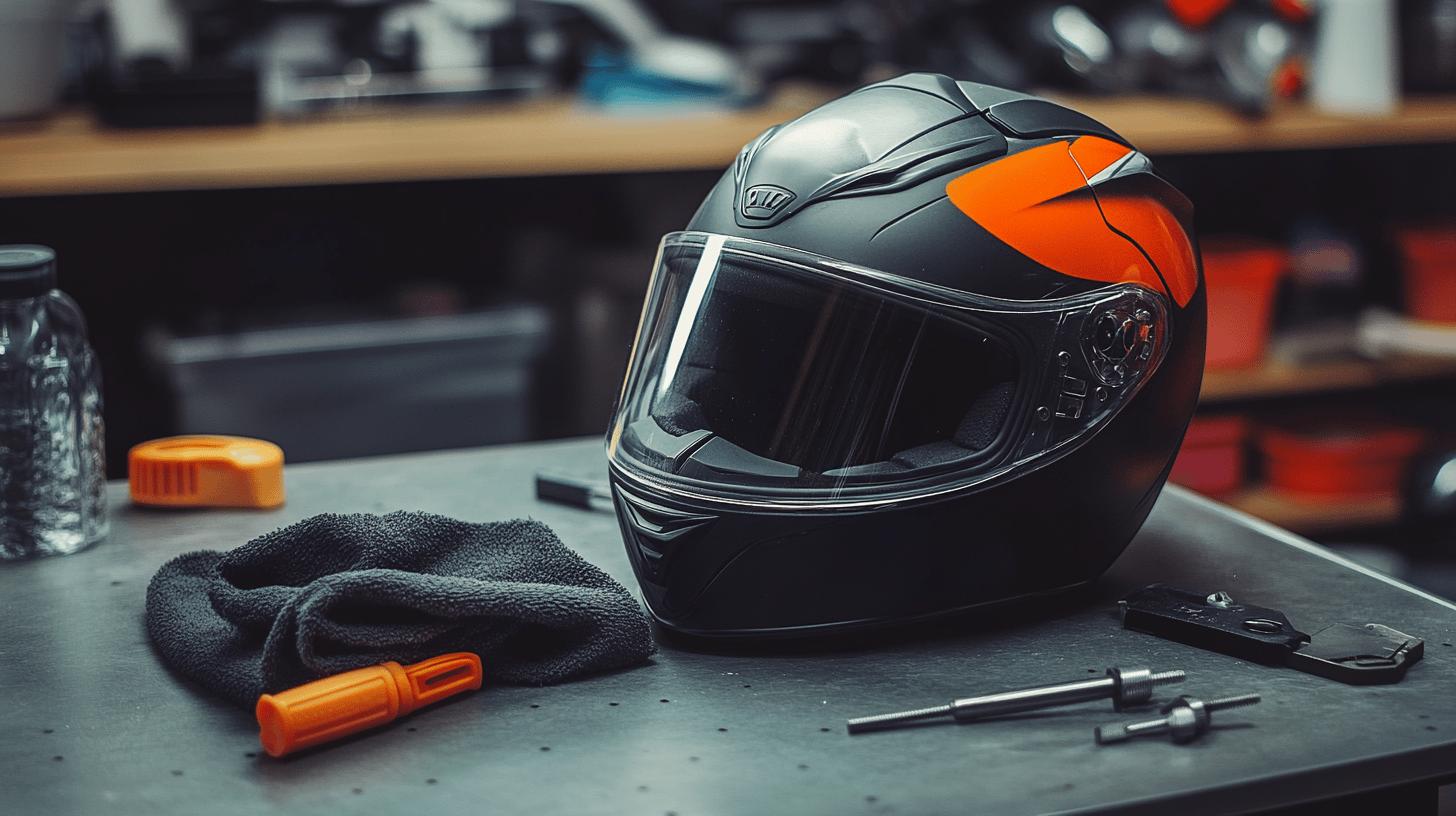Is your helmet visor fogging up or scratched beyond repair? Navigating the maze of helmet visor replacements can seem daunting, but with the right tools and guidance, it's a task every rider can master.
This comprehensive guide leads you through essential preparatory steps and offers detailed techniques to change your helmet visor efficiently. Whether you're dealing with a common visor issue or need brand-specific tips, the insights provided here will empower you to maintain your helmet for enhanced safety and performance.
Ready to upgrade your riding experience? Let's dive into the intricacies of visor replacement.
Tools and Preparations for Changing a Motorcycle Helmet Visor

Preparedness in helmet visor replacement is crucial for ensuring a smooth and efficient process. Having the right tools and setting up an organized workspace can prevent damage to the helmet and make the replacement straightforward.
Initial preparation involves understanding the specific requirements of your helmet model, as visor mechanisms can differ. This stage not only facilitates a seamless swap but also maintains the integrity and longevity of your gear.
- Screwdriver
- Replacement visor
- Soft cloth
- Helmet manual
- Clean workspace
Consulting the helmet's manual is vital for model-specific instructions. The manual often provides details on whether tools such as a screwdriver are necessary, and it can guide you through potentially tricky steps. Preparing the work area by laying down a soft cloth can protect the helmet from scratches during the process. A clean workspace minimizes the risk of losing small components and keeps the replacement visor free from dust and debris, ensuring a clear view once installed.
Step-by-Step Guide to Changing Your Motorcycle Helmet Visor

Changing a motorcycle helmet visor involves a few straightforward steps that vary slightly depending on the helmet model. Generally, the process begins by locating the release mechanism, which is often a tab or button near the ear area of the helmet.
For certain models, this may require unscrewing or unclipping components to remove the visor. Once the old visor is removed, the new visor is aligned and secured in place. Ensuring the visor moves freely and locks securely is crucial to maintaining proper functionality.
Removing the Old Visor
Start by opening the visor to its full extent, providing better access to the release mechanism. Locate the small release tabs or buttons near the ear area of the helmet. Press or slide these tabs to disengage the visor from the helmet. If your helmet model uses screws, use a screwdriver to carefully remove them, keeping track of all small parts. Once released, gently lift the visor away from the helmet and place it in a safe spot to avoid scratches or other damage.
Installing the New Visor
To install the new visor, begin by aligning its tabs with the corresponding slots on the helmet. Ensure the visor is positioned correctly, matching the curve and alignment of the helmet's design. Press the visor into place, listening for a secure click that indicates it is locked in. For helmets requiring screws, reattach them carefully, ensuring a snug fit without overtightening. After installation, test the visor by moving it up and down to confirm smooth operation and secure attachment.
- Difficulty aligning new visor
- Ensuring a secure click sound
- Testing visor movement
Addressing these common challenges ensures a successful visor replacement, enhancing the safety and comfort of your ride.
Safety Tips and Maintenance for Helmet Visors

Regular maintenance of a helmet visor is crucial for ensuring clear visibility and rider safety. How often should you clean your visor? Ideally, after every ride, especially if you encounter dust or insects.
Cleaning the visor with mild soap and water helps maintain its clarity without damaging the material. Avoid using harsh chemicals as they can cause the visor to become brittle or discolored over time, compromising its integrity and potentially impairing vision.
- Use gentle cleaning solutions
- Regularly check for scratches
- Avoid abrasive cloths
- Store helmet in a safe place
Conducting regular safety inspections of your helmet visor is equally important. How can you tell if your visor needs replacing? Look for deep scratches or cracks that could distort your vision. While minor scuffs can be tolerable, significant damage requires immediate attention to avoid visual distractions or hazards. Storing your helmet correctly, preferably in a padded bag or on a flat surface away from direct sunlight, can prolong the visor's life and performance.
Variations in Visor Replacement Across Different Helmet Brands

Motorcycle helmet visor replacement procedures can vary significantly across different brands and models, though many share common elements. Most helmets feature a release mechanism, often involving tabs, buttons, or screws near the ear area.
While the basic premise of detaching and reattaching a visor remains consistent, the specifics can differ. For instance, Harley-Davidson helmets typically use a tab mechanism, while others might require unscrewing components. These distinctions underscore the importance of familiarizing oneself with brand-specific designs to avoid complications during the replacement process.
| Brand | Visor Mechanism |
|---|---|
| Harley-Davidson | Tab mechanism |
| Shoei | Screw and clip system |
| AGV | Quick-release button |
Consulting the manufacturer’s guide is crucial for accurate visor replacement, as it provides detailed instructions tailored to the specific helmet model. This ensures that the replacement is executed smoothly, maintaining the helmet’s safety features and functionality.
Following the guide minimizes the risk of damage to the visor or helmet, and helps in understanding any unique aspects of the brand-specific visor mechanisms. A well-executed visor replacement not only enhances rider safety but also extends the lifespan of the helmet.
Troubleshooting Common Issues During Visor Replacement

Motorcycle helmet visor replacement can sometimes present challenges that require careful attention to overcome. Typical issues include difficulty aligning the new visor, securing it properly in place, and dealing with a stuck release mechanism.
These problems can be frustrating but are usually solvable with some troubleshooting. Aligning the visor correctly often demands precision, as even a slight misalignment can prevent it from snapping securely into place. A release mechanism that refuses to budge might need a bit of gentle persuasion or lubrication, especially if the helmet hasn't been maintained regularly.
- Ensure correct alignment
- Use appropriate tools for securing
- Refer to the helmet manual for tricky mechanisms
Patience is key when dealing with visor replacement challenges. Taking the time to double-check each step, using the right tools, and consulting the helmet’s manual can greatly assist in resolving these issues. The manual often holds the key to understanding the intricacies of a specific model’s release and securement mechanisms.
By leveraging these resources and maintaining a calm approach, riders can effectively manage the complexity of visor removal and installation, ensuring their helmet remains in peak condition for safe riding.
Final Words
Understanding how to change a motorcycle helmet visor is essential for both safety and performance. The process requires careful preparation with tools like a screwdriver and a replacement visor. Following model-specific instructions ensures a seamless visor transition.
Regular maintenance, including cleaning and inspections, further enhances visibility and longevity. Variations exist across helmet brands, so consulting the manual is crucial. Troubleshooting common challenges also helps streamline the task. Mastery of these steps guarantees a safer and more enjoyable riding experience. Embrace these insights for optimal helmet care and confidence on the road.
FAQ
How do you change a motorcycle helmet visor?
To change a motorcycle helmet visor, first locate the release mechanism or screws on either side of the visor. Gently release or unscrew, remove the visor, and replace it with a new one, listening for a secure click.
Can you replace a visor on a motorcycle helmet?
Yes, a visor on a motorcycle helmet can be replaced. Most visors are designed to be removed and reattached easily, enabling users to swap them as needed for maintenance or different riding conditions.
Are motorcycle helmet visors interchangeable?
Motorcycle helmet visors are not universally interchangeable. Compatibility depends on the helmet brand and model. Always check the specific visor model designed for your helmet to ensure proper fit and functionality.
How to remove a scratched visor from a motorcycle helmet?
To remove a scratched visor, locate the screws or release tabs on your helmet. Carefully unscrew or release the visor to avoid further damage, and replace it with a new or scratch-free visor.
How do you safely install a new visor?
To safely install a new visor, align its tabs with the helmet slots. Push gently until you hear a secure clicking sound. Test the visor's movement to confirm it's properly attached and functions smoothly.

Mark Anderson is a trusted expert with over 25 years of riding experience. At 56, his deep knowledge of long-distance touring and participation in major motorcycle rallies makes him a reliable source for gear recommendations on ProtectiveGearz. Mark’s decades of firsthand experience ensure his advice is authoritative and valuable to riders seeking expert guidance.



